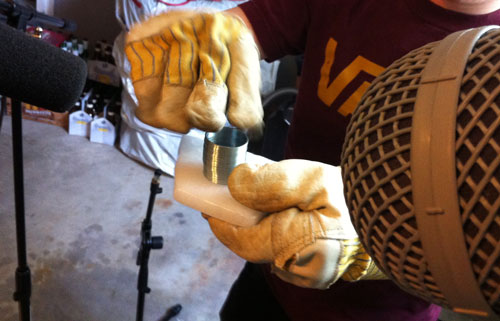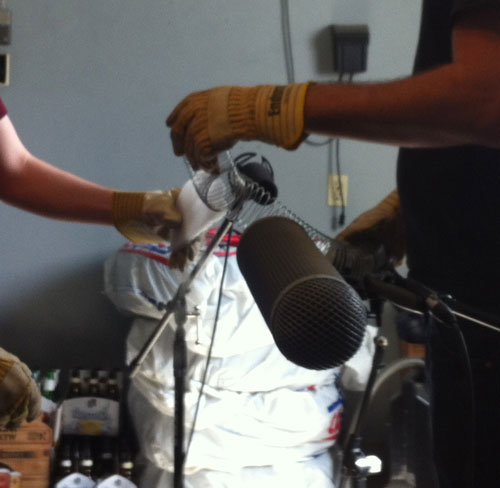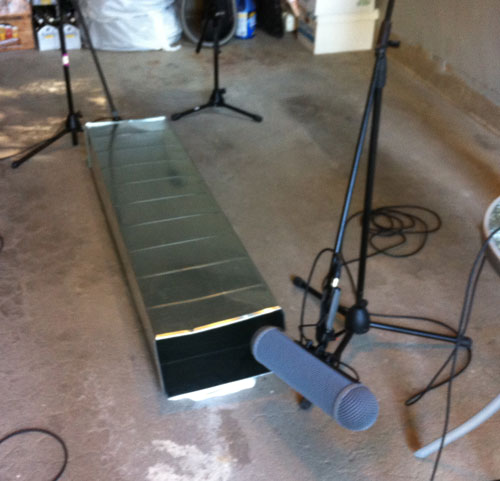Stay Up To Date With Us!
We will never spam you or share your email address.
Game Sound Design Strategies
GSD StrategiesCheck out the gamesounddesign.com strategies when you are feeling creatively uninspired. Each random strategy will present you with a new avenue to pursue. Give them a try!
Game Sound Design Glossary
GSD GlossaryOur game audio glossary has all the sound terms you have been wondering about. Game audio can be confusing enough without having to deal with a new technical language. We are constantly updating the database with new terms that relate to not only game audio but game developer terms as well.
How To: Record Dry Ice
Article by George Spanos
Sometimes you need to take a chance and try to record something completely different. My team and I had been wanting to record dry ice for quite some time. This was partly because we had come across a number of behind-the-scenes videos and read a couple of blog posts about the amazing sounds that can be achieved with dry ice. And they were not lying, you can record some pretty unique sounding groans, screeches, sizzles, and sputters. But before we get into the hows and whys of recording dry ice, I will go through some basic chemistry to give you a better understanding of what dry ice is and where you can find it.
What is dry ice?
Dry ice is basically a solid form of Carbon Dioxide and turns from a solid into a gas at -78.5 degrees Celsius (-109.3 degrees Fahrenheit). This is called sublimation, for those of us who didn't pay attention in chemistry class (your teacher wasn't lying when he told you to pay attention in class). Dry ice is commonly used in vending machines to cool ice cream and pop. It is also the same stuff that is used in nightclubs to create smoke effects and is also used in various industrial applications.
Where can I find dry ice?
Plumbers often use dry ice to freeze pipes so that they don't have to shut off water mains when performing repairs. So a call to your local plumbing supply store can often get you set up with it. You can also call around to welding and gas supply outlets as they often carry it as well. It isn't that expensive, you'll be able to pick up 15 pounds of it for around $25. We found that it sublimates pretty slowly when we were using it... we actually had to leave around a third of it in the gutter after recording for about 3 hours.
Is it safe?
Dry ice is pretty safe. One of the things you have to be aware of is that it can cause burns to your skin if you handle it without any gloves on. But with a pair of leather gardening gloves you will be fine. The other thing to be aware of is that using it in closed spaces that do not have proper air circulation can cause you to feel light-headed. This is because it produces a large amount of carbon dioxide gas when it sublimates, so make sure you use it in a well-ventilated area. Follow basic common sense when using it and you'll be fine.
On To The Fun Stuff
So what kinds of sounds can you expect to get from dry ice? Well, we achieved great sizzles from putting an egg beater onto a piece of it. We recorded some great metal squeals and screeches from putting a slab of it into metal ducting. We also got some good results from empty metal cans, a slinky, metal rods, hollow metal pieces, and a bunch of other metal pieces.


We found some of the best results came from letting the ice vibrate the metal it was in contact with. Pressing metal into the ice can also produce some great sizzles. One thing that we found was that once the surface that was in contact with the ice became cold it didn't resonate as much. I think that's because the freezing stops the metal from vibrating freely. So be sure to have your recorder rolling off the start or you'll have to wait 5-10 minutes for the frozen metal to become supple again.

We had good results using two Sennheiser MKH-416 shotgun microphones into our Sound Devices 722 recorder. The 722 is a great unit with plenty of really smooth and quiet gain on the preamps. We also used a contact microphone into a Zoom H4n and it provided some great results.

Because we wanted to record in a space that had proper ventilation we recorded in a house garage. This enabled us to open the garage door to let fresh air into the space every so often to air out the expelled carbon dioxide. The great thing about the Sennheiser MKH-416 shotgun mics is that they have a really narrow focus so extraneous noises from the sides and rear are attenuated really well which helped us in the garage.

All in all the session was great fun and we learned a lot from it. We got some great sounds that I am sure we will get to use in our upcoming games. These sounds will be perfect for blending and combining into unique stand alone sounds as well as longer sound design ambiences. You can expect to get sounds from dry ice that can be used when designing magic, sci-fi, fire, and metal ronks and screeches.
Check out the video and sound examples to follow and let me know what you think in the comments below!

